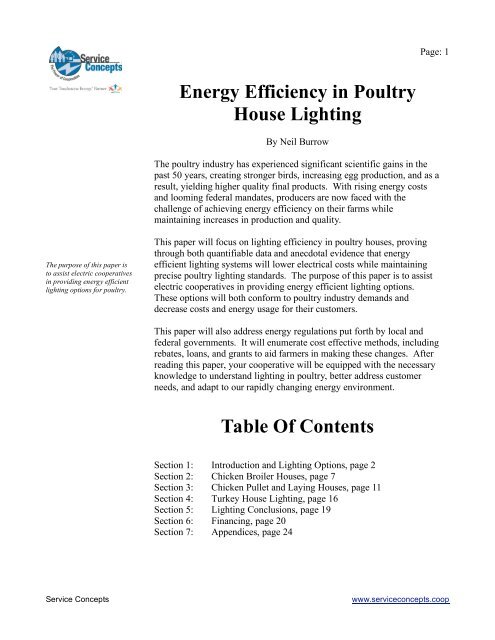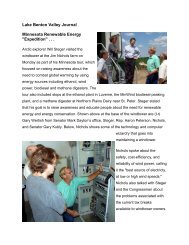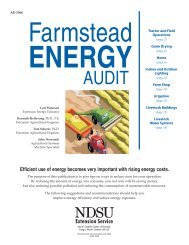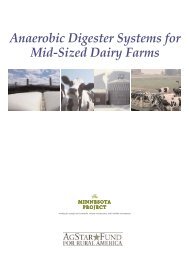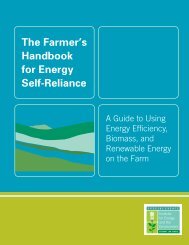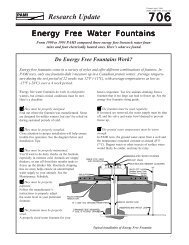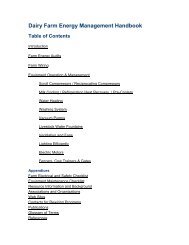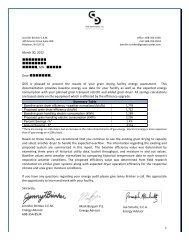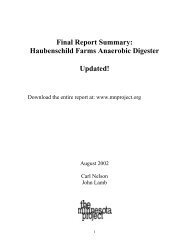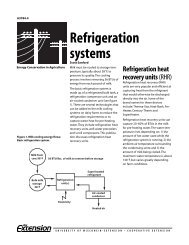Energy Efficiency in Poultry House Lighting - 2009.pdf
Energy Efficiency in Poultry House Lighting - 2009.pdf
Energy Efficiency in Poultry House Lighting - 2009.pdf
Create successful ePaper yourself
Turn your PDF publications into a flip-book with our unique Google optimized e-Paper software.
Page: 1<strong>Energy</strong> <strong>Efficiency</strong> <strong>in</strong> <strong>Poultry</strong><strong>House</strong> Light<strong>in</strong>gBy Neil BurrowThe poultry <strong>in</strong>dustry has experienced significant scientific ga<strong>in</strong>s <strong>in</strong> thepast 50 years, creat<strong>in</strong>g stronger birds, <strong>in</strong>creas<strong>in</strong>g egg production, and as aresult, yield<strong>in</strong>g higher quality f<strong>in</strong>al products. With ris<strong>in</strong>g energy costsand loom<strong>in</strong>g federal mandates, producers are now faced with thechallenge of achiev<strong>in</strong>g energy efficiency on their farms whilema<strong>in</strong>ta<strong>in</strong><strong>in</strong>g <strong>in</strong>creases <strong>in</strong> production and quality.The purpose of this paper isto assist electric cooperatives<strong>in</strong> provid<strong>in</strong>g energy efficientlight<strong>in</strong>g options for poultry.This paper will focus on light<strong>in</strong>g efficiency <strong>in</strong> poultry houses, prov<strong>in</strong>gthrough both quantifiable data and anecdotal evidence that energyefficient light<strong>in</strong>g systems will lower electrical costs while ma<strong>in</strong>ta<strong>in</strong><strong>in</strong>gprecise poultry light<strong>in</strong>g standards. The purpose of this paper is to assistelectric cooperatives <strong>in</strong> provid<strong>in</strong>g energy efficient light<strong>in</strong>g options.These options will both conform to poultry <strong>in</strong>dustry demands anddecrease costs and energy usage for their customers.This paper will also address energy regulations put forth by local andfederal governments. It will enumerate cost effective methods, <strong>in</strong>clud<strong>in</strong>grebates, loans, and grants to aid farmers <strong>in</strong> mak<strong>in</strong>g these changes. Afterread<strong>in</strong>g this paper, your cooperative will be equipped with the necessaryknowledge to understand light<strong>in</strong>g <strong>in</strong> poultry, better address customerneeds, and adapt to our rapidly chang<strong>in</strong>g energy environment.Table Of ContentsSection 1: Introduction and Light<strong>in</strong>g Options, page 2Section 2: Chicken Broiler <strong>House</strong>s, page 7Section 3: Chicken Pullet and Lay<strong>in</strong>g <strong>House</strong>s, page 11Section 4: Turkey <strong>House</strong> Light<strong>in</strong>g, page 16Section 5: Light<strong>in</strong>g Conclusions, page 19Section 6: F<strong>in</strong>anc<strong>in</strong>g, page 20Section 7: Appendices, page 24Service Conceptswww.serviceconcepts.coop
Page: 2Introduction and Light<strong>in</strong>gOptions“New hous<strong>in</strong>g embodies newtechnology, so slow<strong>in</strong>g<strong>in</strong>vestment can h<strong>in</strong>der futureproductivity growth, unlessolder houses can beeffectively retrofited withnewer equipment.”This paper will focus on thebenefits of <strong>in</strong>stall<strong>in</strong>g energyefficient light<strong>in</strong>g <strong>in</strong> broiler,pullet and lay<strong>in</strong>g houses.Introduction to the <strong>Poultry</strong> Industry: The poultry <strong>in</strong>dustry earnedmore than $35 billion <strong>in</strong> cash receipts <strong>in</strong> 2008. Although the <strong>in</strong>dustry isgrow<strong>in</strong>g, there have been fewer entrants <strong>in</strong>to the market <strong>in</strong> recent years.In an analysis of the broiler <strong>in</strong>dustry, James McDonald states, “Newhous<strong>in</strong>g embodies new technology, so slow<strong>in</strong>g <strong>in</strong>vestment can h<strong>in</strong>derfuture productivity growth, unless older houses can be effectivelyretrofited with newer equipment.” 1 New light<strong>in</strong>g techniques that <strong>in</strong>creaseenergy efficiency represent a form of this “retrofitt<strong>in</strong>g,” allow<strong>in</strong>g exist<strong>in</strong>gfarms to offset ris<strong>in</strong>g energy costs and gra<strong>in</strong> prices. McDonald alsopo<strong>in</strong>ts out that while many poultry companies are us<strong>in</strong>g larger contractfarms, over half of broiler production <strong>in</strong> 2008 came from small farms.These small farms are presented with a large opportunity to save energyand enhance <strong>in</strong>dustry competitiveness.Introduction to the Farm Process: The chicken and turkey productionprocess beg<strong>in</strong>s <strong>in</strong> the breeder house. Here, mature hens lay eggs that willeventually form baby pullets (chickens) and poults (turkeys). The eggsare sent to hatcheries where they are <strong>in</strong>cubated and prepared for birth.When the baby chicks hatch, they are immediately transported to housesthat correspond with their purpose. Broilers (birds for meat) aretransported to a broiler house while layers (birds for eggs) are sent to apullet house and then a lay<strong>in</strong>g facility. After broiler birds reach theirdesired weight, they are sent to a process<strong>in</strong>g plant to be used for meatproduction. After hatch<strong>in</strong>g, lay<strong>in</strong>g hens must be developed <strong>in</strong> a pullethouse until they start their reproductive cycle. They are then transferredto a lay<strong>in</strong>g house where they will lay eggs until they are no longerproductive. After the reproductive cycle is complete, lay<strong>in</strong>g hens willaga<strong>in</strong> relocate to a process<strong>in</strong>g facility to be used <strong>in</strong> mature poultryproducts. This paper will focus on the benefits of <strong>in</strong>stall<strong>in</strong>g energyefficient light<strong>in</strong>g <strong>in</strong> broiler, pullet and lay<strong>in</strong>g houses. As you will see,broiler houses have specific light<strong>in</strong>g plans designed to enhance weightga<strong>in</strong>, strengthen the skeletal system, and develop a larger, healthier bird.Lay<strong>in</strong>g houses, and the pullet houses that hold birds before they enter thelay<strong>in</strong>g facilities, utilize light<strong>in</strong>g plans throughout the life of the hen tomaximize reproduction rates.Service Concepts1 McDonald, James, “The Economic Organization of U.S. Broiler Production,” USDA EconomicResearch Service, Economic Information Bullet<strong>in</strong> Number 38, June 2008www.ers.usda.gov/Publications/EIB38/.www.serviceconcepts.coop
Page: 3Light<strong>in</strong>g Options: In the follow<strong>in</strong>g section, each type of bulb availableto poultry farmers will be analyzed.Bulbs That Work With Standard Fixtures:Many small-scale farms may be reluctant to switch light<strong>in</strong>g systemsbecause of high costs to <strong>in</strong>stall new light<strong>in</strong>g fixtures, ballasts, etc. Thefollow<strong>in</strong>g five bulbs use standard light sockets.Incandescent bulbs are<strong>in</strong>efficient because nearly90% of the power used bythe bulb is released as heatrather than lightIncandescent Bulbs: These bulbs have been the traditional bulb choice<strong>in</strong> poultry farms. They are <strong>in</strong>efficient because nearly 90% of the powerused by the bulb is released as heat rather than light. Although this maybe an attractive benefit <strong>in</strong> the w<strong>in</strong>ter, the heat created is <strong>in</strong>efficient whencompared with other heat<strong>in</strong>g options, and the heat produced by thesebulbs will <strong>in</strong>evitably raise cool<strong>in</strong>g costs <strong>in</strong> the summer. 2 Incandescentbulbs have a low up-front cost and a consistent light color. They have alifespan of 1,000 hours or approximately two months if lit 16 hours/day.Although <strong>in</strong>efficient, <strong>in</strong>candescent bulbs have surpris<strong>in</strong>gly seen an<strong>in</strong>crease <strong>in</strong> their usage <strong>in</strong> poultry because they can be dimmed to a verylow light level.Compact Fluorescent Bulbs (CFLs): The most common household andcommercial replacement for the <strong>in</strong>candescent bulb is the spiral CFL (seepicture at left). These bulbs have a 10,000 hour lifespan or almost twoyears if lit 16 hours/day. They use 75% less energy than <strong>in</strong>candescentbulbs accord<strong>in</strong>g to the EPA. 3 A 23-Watt CFL will emit the equivalentlumens (brightness) of a 100-Watt <strong>in</strong>candescent bulb. CFLs are currentlyavailable <strong>in</strong> sufficient wattage for all poultry houses, drop and openceil<strong>in</strong>g. A standard CFL does not have dimm<strong>in</strong>g capabilities. Becauseof their spiral design, dust and dirt can accumulate on CFLs <strong>in</strong> thepoultry environment. CFLs are also more fragile to clean than a standardbulb. CFLs can be purchased as “A-Lamps” with a globe cover<strong>in</strong>g thespirals, and wet location coat<strong>in</strong>g is available to help ease clean<strong>in</strong>g of thebulbs. These solutions are not generally employed <strong>in</strong> poultry because ofheat build-up <strong>in</strong> A-Lamps and additional costs of coat<strong>in</strong>g the bulbs.Most farms f<strong>in</strong>d it more profitable to use cheaper spiral CFLs and cleanthem carefully by hand. Because of their design, CFLs spread light moreevenly throughout the poultry house, which prevents birds fromcluster<strong>in</strong>g <strong>in</strong> one area.Service Concepts2 <strong>Energy</strong> Star, US EPA, http://energystar.custhelp.com/cgib<strong>in</strong>/energystar.cfg/php/enduser/std_adp.php?p_faqid=3868&p_created=1196785588.3 “Compact Fluorescent Light Bulbs,” <strong>Energy</strong> Star, US EPA,http://www.energystar.gov/<strong>in</strong>dex.cfm?c=cfls.pr_cfls.www.serviceconcepts.coop
Page: 4The US Department of<strong>Energy</strong> states, “Compactfluorescent lamps (CFLs)experience higher lumendepreciation compared tol<strong>in</strong>ear sources, but higherquality models generallylose no more than 20% of<strong>in</strong>itial lumens over their10,000 hour life.”F<strong>in</strong>ally, CFLs are often attributed with the negative stigma of lowerperformance late <strong>in</strong> their lifespan. Although this has some validity, theUS Department of <strong>Energy</strong> states, “Compact fluorescent lamps (CFLs)experience higher lumen depreciation compared to l<strong>in</strong>ear sources, buthigher quality models generally lose no more than 20% of <strong>in</strong>itial lumensover their 10,000 hour life.” 4 In order to best combat this issue, farmersshould buy <strong>Energy</strong> Star® rated lamps which are guaranteed to perform athigher than 80% of their orig<strong>in</strong>al lumen output after 4,000 hours 5 and/orbuy lamps with a slightly higher wattage than normally required with an<strong>in</strong>candescent bulb. Throughout all of the cost analyses below, a slightlyhigher bulb wattage is used <strong>in</strong> order to more conservatively estimatesav<strong>in</strong>gs. This will prove that the performance depreciation of CFLs, evenwhen overstated, is not enough to defray cost effectiveness. At the dateof publication, the CFL is the easiest and most tested method toimmediately lower energy costs <strong>in</strong> poultry if the farm is not us<strong>in</strong>g adimmer.Dimmable CFLs: Dimmable CFLs are on the market, but they arecurrently <strong>in</strong>consistent <strong>in</strong> dimm<strong>in</strong>g to extremely low-levels <strong>in</strong> manyhouses (at or below ½ foot-candle). They are also much more expensivethan traditional CFLs. If dimm<strong>in</strong>g is required, farms should use coldcathodesor set up CFLs on separate circuits so that fewer bulbs are usedwhen less <strong>in</strong>tensity is desired.Cold-Cathode Bulbs: Cold-cathodes are a newer technology, a highefficiency fluorescent bulb that lasts approximately 25,000 hours. 6 Coldcathodescome with a globe surround<strong>in</strong>g their light<strong>in</strong>g mechanismmak<strong>in</strong>g them similar to <strong>in</strong>candescent bulbs <strong>in</strong> terms of clean<strong>in</strong>g. Theyconsume slightly more energy than spiral CFLs but are still extremelyefficient when compared to <strong>in</strong>candescent bulbs. An 8-Watt cold-cathodecorresponds to a 40-Watt <strong>in</strong>candescent bulb. The biggest benefit ofcold-cathodes is that they can dim accurately to meet even the lowestlight <strong>in</strong>tensity requirements <strong>in</strong> poultry (usually to under ½ foot-candle). Ifa farmer needs more lumens than an 8-Watt cold cathode can provide,they should comb<strong>in</strong>e cold-cathodes with another light<strong>in</strong>g option,generally a CFL.Service Concepts4 “Lumen Depreciation,” US Department of <strong>Energy</strong>: <strong>Energy</strong> <strong>Efficiency</strong> and Renewable <strong>Energy</strong>,http://www.netl.doe.gov/SSL/us<strong>in</strong>gLeds/general_illum<strong>in</strong>ation_life_depreciation.htm.5 “ENERGY STAR® Program Requirements for CFLs,” <strong>Energy</strong> Star, 10/30/03,http://www.energystar.gov/ia/partners/product_specs/program_reqs/cfls_prog_req.pdf.6 “Cold Cathode Lamp Specifications.” TCP,http://tcpi.com/PDF/1746_1593_02371%20TCP%20CC%20A%20Lamp%20SS%20rev.pdf.www.serviceconcepts.coop
Page: 5Although recently featured <strong>in</strong>some poultry studies, LEDscannot be recommended as astandard light fixture becausethey do not offer the samepayback period, light colorguarantees, or number oftrials as the other fixturesabove.Light Emitt<strong>in</strong>g Diode (LED): LED lights are exceptionally long-last<strong>in</strong>g(approximately 50,000 hours) and now come <strong>in</strong> a variety of colors andoptions. Although recently featured <strong>in</strong> some poultry studies, 7 they cannotbe recommended as a standard light fixture because they do not offer thesame payback period, light color guarantees, or number of trials as theother fixtures above. Some poultry producers are us<strong>in</strong>g colored lights tocalm birds or <strong>in</strong>crease reproduction. If houses are us<strong>in</strong>g blue or redlights, these lights can be changed to LEDs to save energy costs.Bulbs That Require New Light<strong>in</strong>g FixturesTube Fluorescent and High Pressure Sodium bulbs show significantpromise <strong>in</strong> the poultry <strong>in</strong>dustry. They are also some of the most energyefficient light<strong>in</strong>g options on the market today. These options areeconomically viable when compared to <strong>in</strong>candescent bulbs but theirpayoff period is generally a few years.Tube Fluorescents: Tube Fluorescents are similar <strong>in</strong> their output toCFLs but achieve even higher energy efficiency. They ga<strong>in</strong>ed somepopularity <strong>in</strong> the 1980s and are a popular choice <strong>in</strong> the Canadian poultry<strong>in</strong>dustry. In the United States, they have failed to achieve a significantmarket share because of high <strong>in</strong>stallation and ma<strong>in</strong>tenance costs.Because they are <strong>in</strong>stalled <strong>in</strong>side large fixtures, the clean<strong>in</strong>g of thesebulbs is also an extremely tenuous process. If <strong>in</strong>terested <strong>in</strong> tubefluorescents, the Ontario M<strong>in</strong>istry of Agriculture Food & Rural Affairsrecommends the use of T8 Fluorescent bulbs. 8 The follow<strong>in</strong>g l<strong>in</strong>kprovides good <strong>in</strong>formation for <strong>in</strong>terested customers:• www.gtmconf.ca/downloads/presentations/5D4%20-%20Bill%20Rev<strong>in</strong>gton.pdfHigh Pressure Sodium (HPS) Bulbs: HPS bulbs are extremely efficient(approach<strong>in</strong>g 95 lumens per watt). This efficiency, however, is aga<strong>in</strong>offset by a costly <strong>in</strong>stallation and the <strong>in</strong>ability to dim to low light levels.Although extensive test<strong>in</strong>g has not been completed, tests have shown thatbirds do not react negatively to HPS light. 9 HPS bulbs are more popular<strong>in</strong> lay<strong>in</strong>g houses that do not use dimmer switches.Service Concepts7 Van Wicklen, Gary, “More Research Was Needed To Test LED Bulb Effectiveness,” Universityof Delaware, 5/9/2006, http://www.americanfarm.com/<strong>Poultry</strong>5.09.2006d.html.8 Clark, Steve, “<strong>Energy</strong> Efficient <strong>Poultry</strong> Light<strong>in</strong>g,” Ontario M<strong>in</strong>istry of Agriculture Food & RuralAffairs, January 2006, http://www.omafra.gov.on.ca/english/eng<strong>in</strong>eer/facts/06-009.htm.9 Widowski, T<strong>in</strong>a & Vandenburg, Carien “Light<strong>in</strong>g Sources For Broiler Breeders,” University ofGuelph, <strong>Poultry</strong> Industry Council For Research and Education, Factsheet 139, January 2003,www.poultry<strong>in</strong>dustrycouncil.ca/factsheets/fs_139.pdf.www.serviceconcepts.coop
Page: 6Conclusions: In choos<strong>in</strong>g a light<strong>in</strong>g plan, all the options outl<strong>in</strong>ed abovewill improve energy efficiency and save money when compared to<strong>in</strong>candescent bulbs. Below is a chart that displays the energy efficiencyof each light<strong>in</strong>g type. As shown, the energy efficient lights (CFLs, coldcathodesand HPS bulbs) all more than double the efficacy of standard<strong>in</strong>candescent bulbs. 10At the present time,consider<strong>in</strong>g dimm<strong>in</strong>grequirements, up-front costs,and bulb lifespan, the mostcost effective and easilymanageable option forpoultry houses across thecountry is replac<strong>in</strong>g anolder <strong>in</strong>candescent systemwith CFLs for standardlight<strong>in</strong>g needs and coldcathodesfor dimm<strong>in</strong>g.With a small <strong>in</strong>itial <strong>in</strong>vestment (usually $500 or less), most farms canemploy an energy-efficient light<strong>in</strong>g system. A successful poultrylight<strong>in</strong>g plan will adapt one or more of these energy efficient lights to therequirements of <strong>in</strong>dividual farm owners. At the present time,consider<strong>in</strong>g dimm<strong>in</strong>g requirements, up-front costs, and bulb lifespan, themost cost effective and easily manageable option for poultry housesacross the country is replac<strong>in</strong>g an older <strong>in</strong>candescent system with CFLsfor standard light<strong>in</strong>g needs and cold-cathodes for dimm<strong>in</strong>g. In thefollow<strong>in</strong>g sections, an appropriate light<strong>in</strong>g system will be properlymatched with each respective farm type.Service Concepts10 Keefe, T.J., "The Nature of Light," http://www.ccri.edu/physics/keefe/light.htm. TCP,www.tcpi.com.www.serviceconcepts.coop
Page: 7Chicken Broiler <strong>House</strong> Light<strong>in</strong>gUniversal standards aredifficult to apply to broilerhouses because of differ<strong>in</strong>gdimm<strong>in</strong>g requirements,stra<strong>in</strong> crosses (breeds), flocklengths, and hours of lightused per day across the<strong>in</strong>dustry.Broilers are extremelyphotosensitive, so properlight levels are absolutelyessential <strong>in</strong> a broiler housebecause at a low light<strong>in</strong>tensity, birds will be lessactive but still eat sufficientquantities of food to <strong>in</strong>duceample weight ga<strong>in</strong>s.Chicken Broiler <strong>House</strong>s: Broiler houses comprise the largest sector ofpoultry sales. 11 A significant economic opportunity exists <strong>in</strong> broilerhouse light<strong>in</strong>g because many farms rely on <strong>in</strong>candescent bulbs.Universal standards are difficult to apply to broiler houses because ofdiffer<strong>in</strong>g dimm<strong>in</strong>g requirements, stra<strong>in</strong> crosses (breeds), flock lengths,and hours of light used per day across the <strong>in</strong>dustry. Despite thesechallenges, this paper will focus on us<strong>in</strong>g a comb<strong>in</strong>ation of CFLs andcold-cathodes <strong>in</strong> order to achieve optimum light<strong>in</strong>g performance whilem<strong>in</strong>imiz<strong>in</strong>g energy usage and cost <strong>in</strong> broiler houses.General Light<strong>in</strong>g Procedures: There are extreme differences <strong>in</strong> light<strong>in</strong>gspecifications across the broiler <strong>in</strong>dustry. Some broiler houses are solidwalled and must generate all their light from artificial sources. Othershave curta<strong>in</strong>s that can be raised to benefit from natural light on sunnydays. Broilers must receive approximately 3-5 foot-candles of lightdur<strong>in</strong>g brood<strong>in</strong>g. This process lasts 10-14 days and helps the chicksacclimate to their new environment (f<strong>in</strong>d<strong>in</strong>g food and water sources) andstrengthen their skeletal structure, digestive and circulatory systems, andimmune system. After this <strong>in</strong>itial brood<strong>in</strong>g phase, light <strong>in</strong>tensity islowered (generally to around ½ foot-candle) and alternated with shortperiods of complete darkness for the rema<strong>in</strong>der of growout. 12 Broilersare extremely photosensitive, so proper light levels are absolutelyessential <strong>in</strong> a broiler house because at a low light <strong>in</strong>tensity, birds will beless active but still eat sufficient quantities of food to <strong>in</strong>duce ampleweight ga<strong>in</strong>s. Low light <strong>in</strong>tensity also lowers aggression andcannibalism. 13Cold-cathode / CFL Light<strong>in</strong>g System: The follow<strong>in</strong>g data is modeledafter research by Auburn University 14 and the University of ArkansasApplied Broiler Research Farm. 15 The data simulates a 40 feet wide by 500feet long house with 9.5 foot ceil<strong>in</strong>gs. CFLs are used <strong>in</strong> comb<strong>in</strong>ation withcold-cathodes dur<strong>in</strong>g brood<strong>in</strong>g. In the brood area, CFLs must be placed ona separate circuit and should be located on a separate feed l<strong>in</strong>e and/orService Concepts11 “<strong>Poultry</strong> Production and Value.” USDA National Agriculture Statistics Service, April 28, 2008,http://usda.mannlib.cornell.edu/usda/current/PoulProdVa/PoulProdVa-04-28-2008.pdf.12 Donald, Jim, “Controll<strong>in</strong>g Light In Broiler Production.” Auburn University Academic <strong>Poultry</strong>Eng<strong>in</strong>eer<strong>in</strong>g and Economics Newsletter, July 6, 2000,http://www.aces.edu/dept/poultryventilation/documents/Nwsltr-6.pdf.13 Schwean, Karen, “The Welfare of <strong>Poultry</strong>: Review of Recent Literature,” Department of Animaland <strong>Poultry</strong> Science, University of Saskatchewan,http://www.prairiesw<strong>in</strong>e.com/pork<strong>in</strong>sight/welfare_issues/pdf/poultry.pdf.14 Donald, Jim, Auburn University, www.poultryhouse.com.15 Tabler, Tom, University of Arkansas Extension Service, Avian Advice Newsletter,http://www.poultryscience.uark.edu/avian<strong>in</strong>dex.html.www.serviceconcepts.coop
Page: 8Experience <strong>in</strong> AuburnUniversity test<strong>in</strong>g <strong>in</strong>dicates thattemperature rat<strong>in</strong>gs <strong>in</strong> the 2700to 2900-Kelv<strong>in</strong> range providepreferable flock behavior, as4000-Kelv<strong>in</strong> bulbs add moreblue color to the lightspectrum.Incandescent Bulbsalternated every other bulb with cold cathodes. With all the house lights on,a comb<strong>in</strong>ation of CFLs and cold-cathodes should reach well above 3-5foot-candles of light. After the brood<strong>in</strong>g period, the CFLs are turned offand the cold-cathodes are kept runn<strong>in</strong>g. With all the cold-cathodesswitched on, light levels should be able to reach at least 1 foot-candle anddim to light levels at or below ½ foot-candle. In compar<strong>in</strong>g CFLs and coldcathodes,cold-cathodes are longer-last<strong>in</strong>g and have better dimm<strong>in</strong>gcapabilities. Cold-cathodes represent a higher <strong>in</strong>itial cost, but <strong>in</strong> the longterm are the most cost and energy effective bulbs for dimm<strong>in</strong>g <strong>in</strong> broilerhouses. Cold-cathodes are available <strong>in</strong> both a “warm-white” 2700-Kelv<strong>in</strong>temperature rat<strong>in</strong>g and “bright” white 4000-Kelv<strong>in</strong> temperature rat<strong>in</strong>g.Experience <strong>in</strong> Auburn University test<strong>in</strong>g <strong>in</strong>dicates that temperature rat<strong>in</strong>gs<strong>in</strong> the 2700 to 2900-Kelv<strong>in</strong> range provide preferable flock behavior, as4000-Kelv<strong>in</strong> bulbs add more blue color to the light spectrum. These twobulbs have similar prices and identical lumen output. 16<strong>Energy</strong> Cost Analysis: The follow<strong>in</strong>g chart is an analysis of the planoutl<strong>in</strong>ed above. Sixty 100-Watt <strong>in</strong>candescent bulbs are replaced by twenty42-Watt CFLs (150-Watt equivalent) and forty 8-Watt cold-cathodes (40-Watt equivalent). More light power is provided dur<strong>in</strong>g brood<strong>in</strong>g thannormally required <strong>in</strong> order to offset dust and bulb performance loss (as wellas the associated buyer skepticism). From days 12 to 50, brood lights areswitched off and the cold-cathodes are dimmed to approximately ½ footcandle.A medium-sized (6 pound) chicken is used for these calculations.It has an assumed flock length of 50 days and with clean<strong>in</strong>g time <strong>in</strong>cluded,the farm should process six flocks per year.# ofBulbsWattsHoursPer Day# ofDaysIntensitykW HoursUsed<strong>Energy</strong>CostBrood<strong>in</strong>g Period: Day 1-11 60 100 18 12 100% 1296 $129.60Growout Period: Day 12-50 40 100 18 38 44% 1204 $120.38Comb<strong>in</strong>ation of CFLs and Cold-Cathodes# ofBulbsWattsHoursper Day# ofDaysCost Per Flock $249.98IntensitykW HoursUsed<strong>Energy</strong>CostBrood<strong>in</strong>g Period: CFLs 20 42 18 12 100% 181 $18.14Brood<strong>in</strong>g Period: Cold-Cathodes 40 8 18 12 100% 69 $6.91Growout Period: Cold-Cathodes Only 40 8 18 38 80% 175 $17.51<strong>Energy</strong> Cost: Incandescent Bulbs $249.98<strong>Energy</strong> Cost: CFLs and Cold-Cathodes $42.57Cost Sav<strong>in</strong>gs Per Flock $207.42Cost Per Flock $42.57Notes: kW hour cost = $0.10; When measur<strong>in</strong>g <strong>in</strong>tensity %, it was assumed that 20% of a light's efficiency waslost when us<strong>in</strong>g a dimmer, thus a 40-Watt cold-cathode dimmed to 80% = 100-Watt <strong>in</strong>candescent bulb dimmed to44%.Service Concepts16 “Cold Cathode Dimmables.” GoodMart,http://www.goodmart.com/products/cold_cathode_dimmable.htm.www.serviceconcepts.coop
Page: 9Bulb Cost Analysis: Despite energy sav<strong>in</strong>gs of over $200, it is oftenargued that high bulb costs make this switch burdensome for farmowners. While it is true that energy efficient bulbs do represent asignificant <strong>in</strong>itial <strong>in</strong>vestment, the follow<strong>in</strong>g chart proves that the longerlifespan of the bulbs actually makes the purchase of energy-efficientbulbs more cost effective because they are replaced less frequently.Lifespan<strong>in</strong> HoursHoursUsed PerFlockLifespan<strong>in</strong> FlocksPer Bulb# ofBulbsUsedCost ofBulbs# of NewBulbs PerFlockCost of NewBulbs PerFlockIncandescent Bulbs 1,000 900 1.11 44.8 $0.60 40.32 $24.19CFLs 10,000 216 46.30 20 $10.00 0.43 $4.32Cold-Cathodes 25,000 900 27.78 40 $12.00 1.44 $17.28Cost of IncandescentBulbs Per Flock $24.19Cost of CFLs and Cold-Cathodes Per Flock $21.60Cost Sav<strong>in</strong>gs Per Flockof Purchas<strong>in</strong>g New Bulbs $2.59Note: Incandescent bulb usage is scaled back torecognize that only 40 bulbs are lit after brood<strong>in</strong>g period;For calculation purposes, dimm<strong>in</strong>g does not lessen bulblifespan.As shown above, farmers will actually save $2.59 per flock over thelifespan of the energy efficient bulbs <strong>in</strong> addition to direct energy sav<strong>in</strong>gs.With a lifespan of less than a s<strong>in</strong>gle flock, <strong>in</strong>candescent bulbs will alsoneed to be purchased and <strong>in</strong>stalled repeatedly, <strong>in</strong>creas<strong>in</strong>g both labor andenergy costs.Total Cost Analysis: This f<strong>in</strong>al study is a synthesis of the last twoanalyses. It <strong>in</strong>cludes a breakdown of the <strong>in</strong>itial <strong>in</strong>vestment and thereturns on that <strong>in</strong>vestment, display<strong>in</strong>g flock and cost data <strong>in</strong> a yearlyformat. Beyond operat<strong>in</strong>g costs, the environmental impact of energysav<strong>in</strong>gs is also exhibited.Initial Investment # of Bulbs Bulb Cost Total CostCFLs 20 $10.00 $200.00Cold-Cathodes 40 $12.00 $480.00Total Initial Investment $680.00Operat<strong>in</strong>g Costs Per Flock<strong>Energy</strong> Sav<strong>in</strong>gs $207.42Bulb Replacement Sav<strong>in</strong>gs $2.59Total Cost Sav<strong>in</strong>gs Per Flock $210.01Flock Data# of Flocks Per Year 6Payback Period (Flocks) 3.24Payback Period (Days) 161.90Service Conceptswww.serviceconcepts.coop
Page: 10Return on Investment and Operat<strong>in</strong>g Cost Sav<strong>in</strong>gsReturn on Initial Investment, 1st Year 85%Operat<strong>in</strong>g Cost Sav<strong>in</strong>gs, 1 st Year $580.06Annual Return on Investment 185%Annual Operat<strong>in</strong>g Cost Sav<strong>in</strong>gs $1,260.06Annual <strong>Energy</strong> Sav<strong>in</strong>gsAnnual Incandescent Bulb kW Hour Usage 14,999Annual <strong>Energy</strong> Efficient Bulb kW Hour Usage 2,554Total Annual kW Hours Saved 12,445% Change <strong>in</strong> <strong>Energy</strong> <strong>Efficiency</strong> 82.97%Over the course of the first year, <strong>in</strong>clud<strong>in</strong>g the cost of a full light<strong>in</strong>greplacement at the outset, sav<strong>in</strong>gs <strong>in</strong> operat<strong>in</strong>g costs will beapproximately $580. In terms of energy, almost 12,000 kW hours aresaved annually, and the system is 83% more efficient than comparable<strong>in</strong>candescent bulb energy usage. All bulbs should be changedsimultaneously after test<strong>in</strong>g bulb color and light <strong>in</strong>tensity. This willachieve better and more consistent bulb performance, as <strong>in</strong>candescentbulbs will not accurately dim alongside cold-cathodes on the samecircuit.Conclusions and Additional Information: All broiler houses canbenefit from an energy efficient light<strong>in</strong>g system. Cold-cathodes are themost viable bulb choice when dimm<strong>in</strong>g is required, and CFLs shouldimmediately replace <strong>in</strong>candescent bulbs that are not on a dimmer switch.Please contact your local energy cooperative for more detailed costanalyses for large and small broiler birds, as well as comprehensive bulb<strong>in</strong>formation for poultry. Also, please note that due to the uniqueness ofeach farm, all cost studies will have slightly different results. Thefollow<strong>in</strong>g two l<strong>in</strong>ks will provide similar studies from the University ofArkansas and James Madison University. The “dimmable CFLs”featured <strong>in</strong> the 2 nd article are cold-cathodes:• http://www.thepoultrysite.com/articles/1213/energy-efficiencyassociated-with-poultry-house-light<strong>in</strong>g• http://www.vapoultry.com/assets/Docs/George's%20Handout.pdfService Conceptswww.serviceconcepts.coop
Page: 11Chicken Pullet and Lay<strong>in</strong>g <strong>House</strong>sMany pullet houses relyexclusively on <strong>in</strong>candescentbulbs because of dimm<strong>in</strong>grequirements.“There is no evidence thatone type of lamp is betterthan any other for therear<strong>in</strong>g of grow<strong>in</strong>g pullets.”When the pullets beg<strong>in</strong> toage, day lengths areexpanded so that the birdsexpect a long day (simulatedspr<strong>in</strong>g) at the beg<strong>in</strong>n<strong>in</strong>g oftheir reproductive cycle.Introduction: Layer hens are raised <strong>in</strong> a pullet house until they beg<strong>in</strong>lay<strong>in</strong>g eggs. Light<strong>in</strong>g is extremely important <strong>in</strong> pullet and lay<strong>in</strong>g housesbecause it will affect the quality and quantity of eggs produced.Although lumen requirements and house size vary across the <strong>in</strong>dustry,this paper will explore general light<strong>in</strong>g options <strong>in</strong> pullet and lay<strong>in</strong>ghouses that can be modified to fit specific farm requirements. It will usea quantitative approach to show the economic viability of energyefficient lights on both types of farms.Pullet <strong>House</strong>s: Many pullet houses rely exclusively on <strong>in</strong>candescentbulbs because of dimm<strong>in</strong>g requirements. Some have delayed light<strong>in</strong>gupgrades because of lower electric bills relative to lay<strong>in</strong>g houses.Despite this apparent lack of <strong>in</strong>dustry momentum towards a light<strong>in</strong>gswitch, poultry light<strong>in</strong>g experts Peter Lewis and Trevor Morris state,“There is no evidence that one type of lamp is better than any other forthe rear<strong>in</strong>g of grow<strong>in</strong>g pullets.” 17 Because egg quality and quantity iscomparable regardless of light type, this section will show focus on costbenefits available by replac<strong>in</strong>g <strong>in</strong>candescent bulbs with cold-cathodes.At the beg<strong>in</strong>n<strong>in</strong>g of their life cycle, pullets are exposed to a large amountof light <strong>in</strong> order to orient themselves <strong>in</strong> a new environment and f<strong>in</strong>d foodand water sources. After this <strong>in</strong>itial brood<strong>in</strong>g period, light<strong>in</strong>g plansgenerally shorten day lengths, simulat<strong>in</strong>g w<strong>in</strong>ter. When the pullets beg<strong>in</strong>to age, day lengths are expanded so that the birds expect a long day(simulated spr<strong>in</strong>g) at the beg<strong>in</strong>n<strong>in</strong>g of their reproductive cycle, generallybetween 14-18 weeks. Because day length and light <strong>in</strong>tensity have adirect impact on reproduction, dimm<strong>in</strong>g occurs at different <strong>in</strong>tervalsthroughout the pullet process as long as a noticeable difference existsbetween lights on and lights off. 18Service Concepts17 Lewis, Peter and Morris, Trevor, <strong>Poultry</strong> Light<strong>in</strong>g: The Theory and Practice, United K<strong>in</strong>gdom:Northcot, 2006.18 W<strong>in</strong>eland, Michael J., “Importance of Proper Blackout Hous<strong>in</strong>g,” The <strong>Poultry</strong> Site.Com, NorthCarol<strong>in</strong>a State University, http://www.thepoultrysite.com/articles/851/importance-of-properblackout-hous<strong>in</strong>g.www.serviceconcepts.coop
Page: 12<strong>Energy</strong> Cost Analysis: The follow<strong>in</strong>g is an energy cost analysis for apullet barn utiliz<strong>in</strong>g 300 dimmable bulbs. 8-Watt dimmable coldcathodesaccurately replace 40-Watt <strong>in</strong>candescent bulbs.Hours # ofkW Hours <strong>Energy</strong>Incandescent Bulbs# of Bulbs Per Day Days Watts Intensity Used CostBrood<strong>in</strong>g: First 3 Weeks 300 18 21 40 100% 4,536 $453.60Growout: Week 4-17 300 12 98 40 50% 7,056 $705.60Cost Per Flock $1,159.20Hours # ofkW Hours <strong>Energy</strong>Cold-Cathodes# of Bulbs Per Day Days Watts Intensity Used CostBrood<strong>in</strong>g: First 3 Weeks 300 18 21 8 100% 907 $90.72Growout: Week 4-17 300 12 98 8 50% 1,411 $141.12<strong>Energy</strong> Cost: IncandescentBulbs $1,159.20<strong>Energy</strong> Cost: Cold Cathodes $231.84Cost Per Flock $231.84Cost Sav<strong>in</strong>gs Per Flock $927.36 Note: kW hour cost = $0.10As displayed above, cold-cathodes will save approximately $927 over a17-week flock.Bulb Cost Analysis: Cold-cathode bulbs last 25 times longer than<strong>in</strong>candescent bulbs, thus offsett<strong>in</strong>g their high <strong>in</strong>itial bulb cost.Lifespan<strong>in</strong> HoursHoursUsed PerFlockLifespan<strong>in</strong> FlocksPer Bulb# ofBulbsUsedCostofBulbs# of NewBulbs PerFlockCost ofNew BulbsPer FlockIncandescent Bulbs 1,000 1,554 0.64 300 $0.60 466.20 $279.72Cold-Cathodes 25,000 1,554 16.09 300 $12.00 18.65 $223.78Cost of Incandescent Bulbs Per Flock $279.72Cost of Cold-Cathodes Per Flock $223.78Cost Sav<strong>in</strong>gs by Purchas<strong>in</strong>g New Bulbs $55.94By us<strong>in</strong>g cold-cathodes, $55.94 per flock will be saved on bulbpurchases.Service Conceptswww.serviceconcepts.coop
Page: 13Total Cost Analysis: This chart shows that the <strong>in</strong>itial <strong>in</strong>vestment <strong>in</strong> coldcathodesof $3600 will be recouped <strong>in</strong> slightly over one year due to an80% ga<strong>in</strong> <strong>in</strong> energy efficiency.Initial Investment # of Bulbs Bulb Cost Total CostCold-Cathodes 300 $12.00 $3,600.00Total Initial Investment $3,600.00Operat<strong>in</strong>g Costs Per Flock<strong>Energy</strong> Sav<strong>in</strong>gs $927.36Bulb Replacement Sav<strong>in</strong>gs $55.94Total Cost Sav<strong>in</strong>gs Per Flock $983.30Flock Data# of Flocks Per Year 2.61Payback Period (Flocks) 3.66Payback Period (Days) 512.56Return on Investment and Operat<strong>in</strong>g Cost Sav<strong>in</strong>gsReturn on Initial Investment, 1st Year -29%Operat<strong>in</strong>g Cost Sav<strong>in</strong>gs, 1 st Year -$1,036.39Annual Return on Investment 71%Annual Operat<strong>in</strong>g Cost Sav<strong>in</strong>gs $2,563.61Annual <strong>Energy</strong> Sav<strong>in</strong>gsAnnual Incandescent Bulb kW Hour Usage 30,222Annual <strong>Energy</strong> Efficient Bulb kW Hour Usage 6,044Total Annual kW Hours Saved 24,178% Change <strong>in</strong> <strong>Energy</strong> <strong>Efficiency</strong> 80%The scenario above shows a sav<strong>in</strong>gs of over $2,500 and over 24,000 kWhours of energy annually after the <strong>in</strong>itial <strong>in</strong>vestment.Lay<strong>in</strong>g <strong>House</strong>: After 14-18 weeks <strong>in</strong> a pullet house, hens aretransported to a separate lay<strong>in</strong>g facility where they will lay eggs untilthey are approximately 80 weeks old. The lay<strong>in</strong>g house is an easierlocation to implement energy efficient lights because the majority oflay<strong>in</strong>g houses are not us<strong>in</strong>g dimmable lamps. If dimm<strong>in</strong>g is utilized, acold-cathode plan, similar to the one displayed above, can beimplemented. High Pressure Sodium bulbs are a more popular choice <strong>in</strong>lay<strong>in</strong>g houses <strong>in</strong> the southern United States; however, they require newballasts and light<strong>in</strong>g <strong>in</strong>stallations mak<strong>in</strong>g their payoff period muchlonger. Aga<strong>in</strong>, different types of light have not been shown to alter ahen’s lay<strong>in</strong>g performance. 19Service Concepts19 Lewis, Peter and Morris, Trevor, <strong>Poultry</strong> Light<strong>in</strong>g: The Theory and Practice, United K<strong>in</strong>gdom:Northcot, 2006.www.serviceconcepts.coop
Page: 14Dur<strong>in</strong>g the lay<strong>in</strong>g period, most houses require approximately 2 footcandlesof light, which, <strong>in</strong> a high-rise house with lights lowered from theceil<strong>in</strong>g, can be produced by a 60-Watt (or lower) <strong>in</strong>candescent bulb andreplaced by a 14-Watt (or lower) CFL. Hours per day will be gradually<strong>in</strong>creased <strong>in</strong> a step-up light<strong>in</strong>g plan; however, this scenario will showaverage costs and hours per day <strong>in</strong> a typical lay<strong>in</strong>g house <strong>in</strong> order to beeasily applicable across the <strong>in</strong>dustry.<strong>Energy</strong> Cost Analysis: CFLs are used <strong>in</strong> this scenario because theyrepresent the most cost effective light<strong>in</strong>g plan, and dimm<strong>in</strong>g is notrequired.Incandescent Bulbs # of BulbsHoursPer Day# ofDays WattskW HoursUsed<strong>Energy</strong>CostWeek 17 – 80 300 14 441 60 111,132 $11,113.20$11,113.20CFLs# of BulbsIn this barn, over $8,000 can be saved <strong>in</strong> energy costs between weeks 17-80.Bulb Cost Analysis:HoursPer Day# ofDaysWattskW HoursUsedThe new bulbs will lower bulb costs by almost $300 per flock.<strong>Energy</strong>CostWeek 17 – 80 300 14 441 14 25,931 $2,593.08$2,593.08Total Cost –Incandescent $11,113.20Total Cost – CFL $2,593.08Cost Sav<strong>in</strong>gs Per Flock $8,520.12 Note: kW hour cost = $0.10HoursUsed PerFlockLifespan <strong>in</strong>Flocks PerBulb# ofBulbsUsedCostofBulbs# of NewBulbs PerFlockCost of NewBulbs PerFlockLifespan<strong>in</strong> HoursIncandescent Bulbs 1,000 6,174 0.16 300 $0.60 1,852.2 $1,111.32CFLs 10,000 6,174 1.62 300 $4.50 185.2 $833.49Cost of Incandescents Per Flock $1,111.32Cost of CFLs Per Flock $833.49Cost Of Purchas<strong>in</strong>g New Bulbs $277.83Service Conceptswww.serviceconcepts.coop
Page: 15Total Cost Analysis:Initial Investment # of Bulbs Bulb Cost Total CostCFLs 300 $4.50 $1,350.00Total Initial Investment $1,350.00Operat<strong>in</strong>g Costs Per Flock<strong>Energy</strong> Sav<strong>in</strong>gs $8,520.12Bulb Replacement Sav<strong>in</strong>gs $277.83Total Cost Sav<strong>in</strong>gs Per Flock $8,797.95Flock Data# of Flocks Per Year 0.79Payback Period (Flocks) 0.15Payback Period (Days) 70.89Return on Investment and Operat<strong>in</strong>g Cost Sav<strong>in</strong>gsReturn on Initial Investment, 1st Year 415%Operat<strong>in</strong>g Cost Sav<strong>in</strong>gs 1 st Year $5,600.76Annual Return on Investment 515%Annual Operat<strong>in</strong>g Cost Sav<strong>in</strong>gs $6,950.76Annual <strong>Energy</strong> Sav<strong>in</strong>gsAnnual Incandescent Bulb kW Hour Usage 87,799Annual <strong>Energy</strong> Efficient Bulb kW Hour Usage 20,486Total Annual kW Hours Saved 67,313% Change <strong>in</strong> <strong>Energy</strong> <strong>Efficiency</strong> 76.67%Conclusion: As exhibited above, CFLs can save almost $7000 a yearand almost 67,000 kW hours of energy.Service Conceptswww.serviceconcepts.coop
Page: 16Turkey <strong>House</strong> Light<strong>in</strong>gIntroduction: This section will serve to identify best light<strong>in</strong>g practiceswith<strong>in</strong> the turkey <strong>in</strong>dustry. In order to use farm space more effectively,turkey growers normally employ multiple barns for different stages <strong>in</strong> aturkey's life cycle (up to 3 barns <strong>in</strong> a turkey’s lifetime). 20 This lessensthe need for dimmer switches <strong>in</strong> many turkey facilities because eachstage will feature a slightly different light<strong>in</strong>g plan.Although day lengths varybetween 12 and 23 hours,research has shown that 16hours is the optimal daylength for grow<strong>in</strong>g bothmale and female turkeybroilersTurkey Broilers: Also known as grow<strong>in</strong>g turkeys, turkey broilers areraised for meat production. Turkey broilers need high light <strong>in</strong>tensitiesdur<strong>in</strong>g brood<strong>in</strong>g to f<strong>in</strong>d food and water sources and lower light <strong>in</strong>tensitiesfor the rest of the growout period. Turkeys generally brood for 3-5weeks and are then transported to a different house for 11-17 weeks.Turkeys receive at least 5 foot-candles of light dur<strong>in</strong>g brood<strong>in</strong>g and atleast 1 foot-candle for the rest of the flock. 21 Although day lengths varybetween 12 and 23 hours, research has shown that 16 hours is the optimalday length for grow<strong>in</strong>g both male and female turkey broilers. 22Breed<strong>in</strong>g Turkeys: Female breed<strong>in</strong>g turkeys also rotate betweenmultiple barns. They are generally grown <strong>in</strong> a brooder house until theyreach 29 weeks of age. Brood lights, usually on a different circuit, areutilized dur<strong>in</strong>g the early portion of this period. After brood<strong>in</strong>g, light<strong>in</strong>gplans generally use natural light or mimic natural day lengths for 3-4months, employ<strong>in</strong>g 11-14 hour days. Day lengths are then lessened toapproximately 6-7 hours a day to simulate w<strong>in</strong>ter before the reproductivecycle beg<strong>in</strong>s. As the 29-week po<strong>in</strong>t approaches, day lengths aregradually extended to around 14 hours per day, simulat<strong>in</strong>g spr<strong>in</strong>gtime atthe beg<strong>in</strong>n<strong>in</strong>g of the reproductive cycle. At 29 weeks, the hens areshifted to the lay<strong>in</strong>g barn where their production cycle will lastapproximately 26 additional weeks. In the lay<strong>in</strong>g barn, light is generallyheld constant at approximately 14 hours per day at a high light <strong>in</strong>tensityto accentuate the birds’ perceptions of lights on and lights off.Male breeder turkeys (toms) are grown <strong>in</strong> separate barns. Afterbrood<strong>in</strong>g, they are generally grown for 14-hour days at a low-light<strong>in</strong>tensity (2-3 foot-candles) to prevent aggressive behavior. Althoughcolored light is employed on many farms, research has shown that whitelight is just as effective. 23Service Concepts20 “<strong>Poultry</strong> Production Phases,” Purdue University,http://cobweb.ecn.purdue.edu/~epados/ag101/src/poultry.htm.21 W<strong>in</strong>chell, W., “Light<strong>in</strong>g For <strong>Poultry</strong> Hous<strong>in</strong>g,” The Canada Plan Service, The <strong>Poultry</strong> Site,http://www.thepoultrysite.com/articles/452/light<strong>in</strong>g-for-poultry-hous<strong>in</strong>g.22 Lewis, Peter and Morris, Trevor, <strong>Poultry</strong> Light<strong>in</strong>g: The Theory and Practice, United K<strong>in</strong>gdom:Northcot, 2006.23 Lewis, Peter and Morris, Trevor, <strong>Poultry</strong> Light<strong>in</strong>g: The Theory and Practice, United K<strong>in</strong>gdom:Northcot, 2006.www.serviceconcepts.coop
Page: 17<strong>Energy</strong> Cost Analysis: The follow<strong>in</strong>g cost analysis focuses on a genericturkey barn (broiler or lay<strong>in</strong>g) featur<strong>in</strong>g sixty <strong>in</strong>candescent bulbs (100-Watt), which will be replaced by sixty 42-Watt CFLs (150-Wattequivalent). By us<strong>in</strong>g a stronger CFL, the study represents aconservative estimate of energy sav<strong>in</strong>gs, add<strong>in</strong>g more light than generallyrequired to show the substantial cost benefit of switch<strong>in</strong>g to spiral CFLs.Turkey barns should use a light meter to determ<strong>in</strong>e the lumen output andexact wattage size of CFLs for their barn.As a general plan (discount<strong>in</strong>g external factors such as the season andbarn light<strong>in</strong>g layout), this analysis displays the value of CFLs over<strong>in</strong>candescent bulbs for any similar turkey house. The energy sav<strong>in</strong>gs arepresented <strong>in</strong> a monthly format so that they can be easily transferable tolarger or smaller barns.# of Hours # ofkW Hours <strong>Energy</strong>Incandescent BulbsBulbs Per Day Days Watts Used Cost1 Month Cost Study 60 14 30 100 2,520 $252.00# of Hours # ofkW Hours <strong>Energy</strong>CFLsBulbs Per Day Days Watts Used Cost1 Month Cost Study 60 14 30 42 1,058.4 $105.84<strong>Energy</strong> Cost: Incandescent Bulbs $252.00<strong>Energy</strong> Cost: CFLs $105.84Cost Sav<strong>in</strong>gs Per Month $146.16 Note: kW hour cost = $0.10It is shown that sav<strong>in</strong>gs are $146.16 per month <strong>in</strong> electricity costs.Bulb Cost Analysis: The follow<strong>in</strong>g chart shows monthly bulb cost afterthe <strong>in</strong>itial change is made.HoursUsed PerMonthLifespan <strong>in</strong>MonthsPer Bulb# ofBulbsUsedCostofBulbs# of NewBulbs PerMonthAt $10 per bulb, there will be an additional cost of $10.08 per month fornew bulbs.Cost ofNew BulbsPer MonthLifespan<strong>in</strong> HoursIncandescent Bulbs 1,000 420 2.38 60 $0.60 25.2 $15.12CFLs 10,000 420 23.81 60 $10.00 2.52 $25.20Cost of Incandescent Bulbs Per Month $15.12Cost of CFLs Per Month $25.20Cost of Purchas<strong>in</strong>g New Bulbs $10.08Service Conceptswww.serviceconcepts.coop
Page: 18Total Cost Analysis: The next chart shows a yearly cost analysis andpayback periods for a full light<strong>in</strong>g replacement.Initial Investment # of Bulbs Bulb Cost Total CostCFLs 60 $10.00 $600.00Total Initial Investment $600.00Operat<strong>in</strong>g Costs Per Month<strong>Energy</strong> Sav<strong>in</strong>gs $146.16Bulb Replacement Sav<strong>in</strong>gs -$10.08Total Cost Sav<strong>in</strong>gs Per Flock $136.08Payback PeriodPayback Period (Days) 136.68Return on Investment and Operat<strong>in</strong>g Cost Sav<strong>in</strong>gsReturn on Initial Investment, 1st Year 172%Operat<strong>in</strong>g Cost Sav<strong>in</strong>gs 1 st Year $1,032.96Annual Return on Investment 272%Annual Operat<strong>in</strong>g Cost Sav<strong>in</strong>gs $1,632.96Annual <strong>Energy</strong> Sav<strong>in</strong>gsAnnual Incandescent Bulb kW Hour Usage 30,240Annual <strong>Energy</strong> Efficient Bulb kW Hour Usage 12,701Total Annual kW Hours Saved 17,539% Change <strong>in</strong> <strong>Energy</strong> <strong>Efficiency</strong> 58%By switch<strong>in</strong>g to spiral CFLs, even a small turkey barn accommodat<strong>in</strong>gonly 60 bulbs will save over $1,200 and 20,000 kW hours of energy <strong>in</strong>the first year alone. After the first year, sav<strong>in</strong>gs are <strong>in</strong>creased to $1866per barn.Service Conceptswww.serviceconcepts.coop
Page: 19Light<strong>in</strong>g ConclusionsThis paper <strong>in</strong>dicates that energy efficient light<strong>in</strong>g can be used <strong>in</strong> poultryhouses for a significant ga<strong>in</strong> <strong>in</strong> energy sav<strong>in</strong>gs. These general rulesshould be adopted based on circumstances present <strong>in</strong> poultry farms.• Use cold-cathodes when low-light <strong>in</strong>tensity and dimm<strong>in</strong>g isneeded. If cold-cathodes are not able to fulfill the foot-candlerequirements dur<strong>in</strong>g brood<strong>in</strong>g/growout, comb<strong>in</strong>e them with spiralCFLs on a different circuit and/or alternat<strong>in</strong>g bulbs to replace theneed for <strong>in</strong>candescent bulbs.• In houses where dimm<strong>in</strong>g is not required, spiral CFLs should be<strong>in</strong>stalled. They offer more uniform light coverage, more energyefficiency and lower costs than <strong>in</strong>candescent bulbs. HighPressure Sodiums are not as yet a proven solution because of longpayback periods.• Spiral CFLs should be cleaned by hand, but their long life andenergy cost sav<strong>in</strong>gs will outweigh any additional labor costs.• Local electricity cooperatives are good sources of <strong>in</strong>formationregard<strong>in</strong>g proper recycl<strong>in</strong>g of CFLs.• Despite perceived bulb performance loss, most CFLs will loseless than 20% of their orig<strong>in</strong>al foot-candles of light, and, asproven above, buy<strong>in</strong>g a slightly higher wattage CFL still garnersappreciable f<strong>in</strong>ancial benefits for the farmer.• Considerable sav<strong>in</strong>gs are possible even for those with smallerfarms and m<strong>in</strong>imal light<strong>in</strong>g needs.Service Conceptswww.serviceconcepts.coop
Page: 20F<strong>in</strong>anc<strong>in</strong>gThe <strong>in</strong>itial cost of an energy efficiency transition can be significantlydim<strong>in</strong>ished through a variety of f<strong>in</strong>anc<strong>in</strong>g and rebate plans. A goodstart<strong>in</strong>g po<strong>in</strong>t for most farmers is the USDA energy estimator tool thatfarmers can use to approximate their energy usage:• http://ahat.sc.egov.usda.govGovernmental Requirements and RebatesRenewable <strong>Energy</strong> Portfolio Standard: Federal and state governmentsare enact<strong>in</strong>g new standards that require energy efficiency. Currently,thirty states sponsor a Renewable <strong>Energy</strong> Portfolio Standard (RPS orREPS), which mandates efficiency improvements by local cooperatives.Your state’s energy efficiency program can be found at:• http://apps1.eere.energy.gov/states/maps/renewable_portfolio_states.cfmThe 2007 United States<strong>Energy</strong> Bill announced thatall <strong>in</strong>candescent bulbs wouldbe banned between 2012and 2014<strong>Energy</strong> efficient light bulb upgrades can be counted towards REPSrequirements. If current trends cont<strong>in</strong>ue, mandates similar to REPS willlikely spread throughout the United States. The 2007 United States<strong>Energy</strong> Bill announced that all <strong>in</strong>candescent bulbs would be bannedbetween 2012 and 2014. 24 As a result, immediate transition yields notonly economic rewards but represents a preemptive compliance withgovernment standards.F<strong>in</strong>anc<strong>in</strong>g through CooperativesIntroduction: F<strong>in</strong>anc<strong>in</strong>g for energy efficient measures can be difficultto obta<strong>in</strong>; however, this paper concludes that energy efficient light<strong>in</strong>gchanges are f<strong>in</strong>ancially beneficial <strong>in</strong> the long term and should beimplemented regardless of whether a rebate plan is available. <strong>Energy</strong>sav<strong>in</strong>gs will far outweigh the costs of such measures but a smallcooperative rebate plan can be successful <strong>in</strong> creat<strong>in</strong>g demand andencourag<strong>in</strong>g <strong>in</strong>vestment <strong>in</strong> energy efficiency.Cooperative Rebates: The most common f<strong>in</strong>anc<strong>in</strong>g plan offered bycoops throughout the nation is a simple $2 rebate for CFL purchases.Other cooperatives offer rebates on fixtures for energy efficientService Concepts24 “U.S. <strong>Energy</strong> Bill Phases Out Incandescent Light Bulb,” Environmental Leader, December 18,2007. http://www.environmentalleader.com/2007/12/18/us-energy-bill-phases-out-<strong>in</strong>candescentlight-bulb/.www.serviceconcepts.coop
Page: 21light<strong>in</strong>g, 25 or plans based on a percentage of money saved by thecustomer. 26PAYS Model – Pay As You Save: 27 At least two energy cooperativesare now offer<strong>in</strong>g energy efficiency programs with no up-front cost fortheir members. The programs are SmartSTART by the New HampshireElectric Coop and How$mart by Midwest <strong>Energy</strong>. They are applicable <strong>in</strong>all cases where energy sav<strong>in</strong>gs are greater than the total cost of thestructural improvements:• http://www.nhec.com/bus<strong>in</strong>ess_energysolutions_smartstart.php• http://www.mwenergy.com/howsmart.aspxIn a recent <strong>in</strong>dustry report,Mississippi State Universitygave 22 different options forimprov<strong>in</strong>g energy efficiency<strong>in</strong> poultry housesThe programs require an energy audit (provided free of charge <strong>in</strong> the caseof How$mart), pay<strong>in</strong>g for the improvements with a guarantee of a lowerenergy bill for the customer. For example, if total sav<strong>in</strong>gs are calculatedas 100% of energy cost reduction, the program fees will amount to 75%of the energy sav<strong>in</strong>gs (used to fund the improvements and pay thecooperative), and 25% of the sav<strong>in</strong>gs will be seen <strong>in</strong> a lower monthly bill.Both programs require that <strong>in</strong>dividual farms and bus<strong>in</strong>ess ownerscomplete the energy efficiency upgrades after an energy audit. In arecent <strong>in</strong>dustry report, Mississippi State University gave 22 differentoptions for improv<strong>in</strong>g energy efficiency <strong>in</strong> poultry houses. 28 S<strong>in</strong>celight<strong>in</strong>g comprised only two of these 22 options, these light<strong>in</strong>g changescan be comb<strong>in</strong>ed with other energy efficiency upgrades, and an energyaudit <strong>in</strong> poultry houses can represent a substantial economic benefit forboth farmers and cooperatives.F<strong>in</strong>anc<strong>in</strong>g through GovernmentsResources for Local F<strong>in</strong>anc<strong>in</strong>g: The follow<strong>in</strong>g l<strong>in</strong>ks are comprehensiveresources for government f<strong>in</strong>anc<strong>in</strong>g and energy efficiency programs,show<strong>in</strong>g energy efficiency rebates, grants, and loans on a state-by-statedatabase:• http://www.dsireusa.org• http://www.goodtobegreen.com/F<strong>in</strong>ancialIncentives.aspxService Concepts25 “Rebates Offered - Shedd<strong>in</strong>g Light on <strong>Energy</strong> <strong>Efficiency</strong>,”Jackson Electric Cooperative,http://www.jackelec.com/commercial_<strong>in</strong>dustrial/rebates_offered.html.26 “<strong>Energy</strong> <strong>Efficiency</strong> Rebates,” Midstate Electric Cooperative,”http://www.midstateelectric.coop/ProductsAndServices/CommercialIndustrial/<strong>Energy</strong><strong>Efficiency</strong>Programs/default.aspx.27 “Pays America,” http://www.paysamerica.org/.28 Smith, Tom W. Jr., “Reduc<strong>in</strong>g <strong>Energy</strong> Costs In <strong>Poultry</strong> <strong>House</strong>s,” Mississippi State University,http://www.msstate.edu/dept/poultry/pubs/is1617.htm.www.serviceconcepts.coop
Page: 22For directories and state resources <strong>in</strong>clud<strong>in</strong>g local communitydevelopment use:• http://www.agmrc.org/directories__state_resourcesFor resources about susta<strong>in</strong>able agriculture, please visit:• http://attra.ncat.orgLocal Economic Development Organizations: When look<strong>in</strong>g for helpregard<strong>in</strong>g energy efficiency rebates and programs, customers can bereferred to local or state economic development organization. An onl<strong>in</strong>edirectory for economic development organizations is under constructionat the follow<strong>in</strong>g website:• http://www.sitelocationassistance.com/search/regions/usa/default.htm#gaccIn 2008, the federalgovernment gave almost $20million to assist farmers,ranchers and smallbus<strong>in</strong>esses for renewableenergy systems and energyefficiency improvements.Rural <strong>Energy</strong> For America Program (REAP): Rural bus<strong>in</strong>ess canqualify for government subsidies based on energy efficient practices. In2008, the federal government gave almost $20 million to assist farmers,ranchers and small bus<strong>in</strong>esses for renewable energy systems and energyefficiency improvements. For qualify<strong>in</strong>g energy efficiency projects, theprogram offers a 25% grant (m<strong>in</strong>imum $1500, maximum $250,000) and upto a 75% loan. More <strong>in</strong>formation is available onl<strong>in</strong>e at USDA's website:• http://www.rurdev.usda.gov/rbs/farmbill/<strong>in</strong>dex.htmlIf a light<strong>in</strong>g switch alone does not reach the required amount of sav<strong>in</strong>gs orcosts for the program, light<strong>in</strong>g upgrades can be comb<strong>in</strong>ed with other energyefficiency projects to atta<strong>in</strong> the required eligibility. Two poultry farmers <strong>in</strong>South Carol<strong>in</strong>a received over $25,000 for energy efficiency improvementslast year that <strong>in</strong>cluded light<strong>in</strong>g system enhancements. 29Research Grants: If member farms or bus<strong>in</strong>esses are <strong>in</strong>terested <strong>in</strong>conduct<strong>in</strong>g research <strong>in</strong> susta<strong>in</strong>ability and energy efficiency, Susta<strong>in</strong>ableAgriculture Research and Education (SARE) offers grants of up to$150,000:• http://www.sare.org/grants/Service Concepts29 “Six S.C. Projects Awarded Grant Funds From USDA,” South Carol<strong>in</strong>a <strong>Energy</strong> Office,September 20, 2008, http://www.energy.sc.gov/news.aspx?id=94.www.serviceconcepts.coop
Page: 23Conclusions: As energy costs cont<strong>in</strong>ue to rise, an energy efficient light<strong>in</strong>gplan is an essential component of a sound long-term bus<strong>in</strong>ess model. Astechnology has improved, opportunities to cut costs while sav<strong>in</strong>g energyhave become more readily available. The <strong>in</strong>flux of government assistanceprograms as well as opportunities to save through local cooperative rebateshave made upgrad<strong>in</strong>g a farm’s energy profile more feasible and affordablethan ever before. An energy efficient light<strong>in</strong>g plan is a rapid andmanageable method by which poultry farms can drastically cut costs andrema<strong>in</strong> viable and profitable bus<strong>in</strong>esses <strong>in</strong> the years to come.Contact Information:Neil BurrowService Concepts720 North High School RoadIndianapolis, In 46214877.738.6824317.487.2271 (fax)nburrow@serviceconcepts.coopAbout Service Concepts: Service Concepts sponsored this paper for thepurpose of distribution to electricity cooperatives and farmers across thenation to better address poultry light<strong>in</strong>g needs. In 1999, 32 rural electricutilities formed Service Concepts to foster <strong>in</strong>novation and enhance supplierrelationships with<strong>in</strong> the energy, telecommunications, and related <strong>in</strong>dustries.In order to address concerns over ris<strong>in</strong>g energy costs and the environment,Service Concepts facilitates relevant studies, educational programs, andmanufacture-direct product relationships to support the adoption of energyefficient light<strong>in</strong>g. Service Concepts now serves electric utilities and theircustomers <strong>in</strong> every state <strong>in</strong> the United States. For more <strong>in</strong>formation, pleasevisit www.serviceconcepts.coop.Acknowledgments: The broiler section of this paper was made possiblewith collaboration from the National <strong>Poultry</strong> Technology Center, AuburnUniversity. Special thanks to Dr. Gene Simpson and Professor Jim Donald.For more <strong>in</strong>formation about poultry light<strong>in</strong>g and energy efficiency <strong>in</strong>poultry houses, please visit their website at www.poultryhouse.com.©Service Concepts 2009 - All rights reserved. For permission to copy ordistribute, contact Service Concepts, adm<strong>in</strong>@serviceconcepts.coop.Service Conceptswww.serviceconcepts.coop
Page: 24Appendix 1: Broiler <strong>House</strong> Cost Analysis, Small Size Chicken (4 lb) witha 37-day flock length and seven total flocks per year.Incandescent Bulbs# ofBulbsWattsHoursPer Day# ofDaysIntensitykW HoursUsed<strong>Energy</strong>CostBrood<strong>in</strong>g Period: Day 1-11 60 100 18 12 100% 1296 $129.60Growout Period: Day 12-50 40 100 18 25 44% 792 $79.20Comb<strong>in</strong>ation of CFLs and ColdCathodes# ofBulbsWattsHoursPer Day# ofDaysCost Per Flock $208.80IntensitykW HoursUsed<strong>Energy</strong>CostBrood<strong>in</strong>g Period: CFLs 20 42 18 12 100% 181 $18.14Brood<strong>in</strong>g Period: Cold-Cathodes 40 8 18 12 100% 69 $6.91Growout Period: Cold-Cathodes Only 40 8 18 25 80% 115 $11.52<strong>Energy</strong> Cost: Incandescent Bulbs $208.80<strong>Energy</strong> Cost: CFLs and Cold-Cathodes $36.58Cost Sav<strong>in</strong>gs Per Flock $172.22Cost per Flock $36.58Notes: KW / Hour Cost = $0.10; When measur<strong>in</strong>g <strong>in</strong>tensity %, it was assumed that 20% of a light's efficiency waslost when us<strong>in</strong>g a dimmer, thus a 40-Watt cold-cathode dimmed to 80% = 100-Watt <strong>in</strong>candescent bulb dimmed to44%.Bulb Cost Analysis:Lifespan<strong>in</strong> HoursHoursUsed PerFlockLifespan<strong>in</strong> FlocksPer Bulb# of BulbsUsedCostofBulbs# of NewBulbs PerFlockCost of NewBulbs PerFlockIncandescent Bulbs 1,000 666 1.50 46.48648649 $0.60 30.96 $18.58CFLs 10,000 216 46.30 20 $10.00 0.43 $4.32Cold-Cathodes 25,000 666 37.54 40 $12.00 1.07 $12.79Cost of IncandescentBulbs Per Flock $18.58Cost of CFLs and Cold-Cathodes Per Flock $17.11Cost Sav<strong>in</strong>gs Per Flock ofPurchas<strong>in</strong>g New Bulbs $1.47Note: Incandescent bulb usage is scaled back to recognize thatonly 40 bulbs are lit after brood<strong>in</strong>g period; For calculationpurposes, dimm<strong>in</strong>g does not lessen bulb lifespan.Service Conceptswww.serviceconcepts.coop
Page: 25Total Cost Analysis:Initial Investment # of Bulbs Bulb Cost Total CostCFLs 20 $10.00 $200.00Cold-Cathodes 40 $12.00 $480.00Total Initial Investment $680.00Operat<strong>in</strong>g Costs Per Flock<strong>Energy</strong> Sav<strong>in</strong>gs $172.22Bulb Replacement Sav<strong>in</strong>gs $1.47Total Cost Sav<strong>in</strong>gs Per Flock $173.69Flock Data# of Flocks Per Year 7Payback Period (Flocks) 3.91Payback Period (Days) 144.85Return on Investment and Operat<strong>in</strong>g Cost Sav<strong>in</strong>gsReturn on Initial Investment, 1st Year 79%Operat<strong>in</strong>g Cost Sav<strong>in</strong>gs, 1 st Year $535.85Annual Return on Investment 179%Annual Operat<strong>in</strong>g Cost Sav<strong>in</strong>gs $1,215.85Annual <strong>Energy</strong> Sav<strong>in</strong>gsAnnual Incandescent Bulb kW Hour Usage 14,616Annual <strong>Energy</strong> Efficient Bulb kW Hour Usage 2,560Total Annual kW Hours Saved 12,056% Change <strong>in</strong> <strong>Energy</strong> <strong>Efficiency</strong> 82.48%Service Conceptswww.serviceconcepts.coop
Page: 26Appendix 2: Broiler <strong>House</strong> Cost Analysis- Large Size Chicken (7-8 lbs)with a 60-day flock and five total flocks per year.Incandescent Bulbs# ofBulbsWattsHoursper Day# ofDaysIntensitykW HoursUsed<strong>Energy</strong>CostBrood<strong>in</strong>g Period: Day 1-11 60 100 18 12 100% 1296.00 $129.60Growout Period: Day 12-50 40 100 18 48 44% 1520.64 $152.06Comb<strong>in</strong>ation of CFLs and Cold-Cathodes# ofBulbsWattsHoursper Day# ofDaysCost Per Flock $281.66IntensitykW HoursUsed<strong>Energy</strong>CostBrood<strong>in</strong>g Period: CFLs 20 42 18 12 100% 181.44 $18.14Brood<strong>in</strong>g Period: Cold-Cathodes 40 8 18 12 100% 69.12 $6.91Growout Period: Cold-Cathodes Only 40 8 18 48 80% 221.18 $22.12<strong>Energy</strong> Cost: Incandescent Bulbs $281.66<strong>Energy</strong> Cost: CFLs and Cold-Cathodes $47.17Cost Sav<strong>in</strong>gs Per Flock $234.49Cost Per Flock $47.17Notes: kW hour Cost = $0.10; When measur<strong>in</strong>g <strong>in</strong>tensity %, it was assumed that 20% of a light's efficiency waslost when us<strong>in</strong>g a dimmer, thus a 40-Watt cold-cathode dimmed to 80% = 100-Watt <strong>in</strong>candescent bulb dimmed to44%.Bulb Cost Analysis:Lifespan<strong>in</strong> HoursHoursUsed PerFlockLifespan<strong>in</strong> FlocksPer Bulb# ofBulbsUsedCost ofBulbs# of NewBulbs PerFlockCost of NewBulbs PerFlockIncandescent Bulbs 1,000 1080 0.93 44 $0.60 47.52 $28.51CFLs 10,000 216 46.30 20 $10.00 0.43 $4.32Cold-Cathodes 25,000 1080 23.15 40 $12.00 1.73 $20.74Cost of IncandescentBulbs Per Flock $28.51Cost of CFLs and Cold-Cathodes Per Flock $25.06Cost Sav<strong>in</strong>gs Per Flock ofPurchas<strong>in</strong>g New Bulbs $3.46Note: Incandescent bulb usage is scaled back torecognize that only 40 bulbs are lit after brood<strong>in</strong>g period;For calculation purposes, dimm<strong>in</strong>g does not lessen bulblifespan.Service Conceptswww.serviceconcepts.coop
Page: 27Total Cost Analysis:Initial Investment # of Bulbs Bulb Cost Total CostCFLs 20 $10.00 $200.00Cold-Cathodes 40 $12.00 $480.00Total Initial Investment $680.00Operat<strong>in</strong>g Costs Per Flock<strong>Energy</strong> Sav<strong>in</strong>gs $234.49Bulb Replacement Sav<strong>in</strong>gs $3.46Total Cost Sav<strong>in</strong>gs Per Flock $237.95Flock Data# of Flocks Per Year 5Payback Period (Flocks) 2.86Payback Period (Days) 171.47Return on Investment and Operat<strong>in</strong>g Cost Sav<strong>in</strong>gsReturn on Initial Investment, 1st Year 75%Operat<strong>in</strong>g Cost Sav<strong>in</strong>gs, 1 st Year $509.73Annual Return on Investment 175%Annual Operat<strong>in</strong>g Cost Sav<strong>in</strong>gs $1,189.73Annual <strong>Energy</strong> Sav<strong>in</strong>gsAnnual Incandescent Bulb kW Hour Usage 14,083Annual <strong>Energy</strong> Efficient Bulb kW Hour Usage 2,359Total Annual kW Hours Saved 11,724% Change <strong>in</strong> <strong>Energy</strong> <strong>Efficiency</strong> 83.25%Service Conceptswww.serviceconcepts.coop
Page: 28Appendix 3: Pullet Barn Cost Analysis with 5-Watt cold-cathodesreplac<strong>in</strong>g 25-Watt <strong>in</strong>candescent bulbs.# of Hours # ofDimmed kW Hours <strong>Energy</strong>Incandescent BulbsBulbs Per Day Days Watts To Used CostBrood<strong>in</strong>g: First 3 Weeks 300 18 21 25 100.00% 2,835 $283.50Growout: Week 4-17 300 12 98 25 50.00% 4,410 $441.00$724.50# of Hours # ofDimmed kW Hours <strong>Energy</strong>Cold-CathodesBulbs Per Day Days Watts To Used CostBrood<strong>in</strong>g: First 3 Weeks 300 18 21 5 100.00% 567 $56.70Growout: Week 4-17 300 12 98 5 50.00% 882 $88.20<strong>Energy</strong> Cost: Incandescent Bulbs $724.50<strong>Energy</strong> Cost: Cold Cathodes $144.90Cost Sav<strong>in</strong>gs Per Flock $579.60 Note: kW hour cost = $0.10$144.90Bulb Cost Analysis:Lifespan<strong>in</strong> HoursHoursUsed PerFlockLifespan<strong>in</strong> FlocksPer Bulb# ofBulbsUsedCostofBulbs# of NewBulbs PerFlockCost ofNew BulbsPer FlockCost of Incandescent Bulbs 1,000 1,554 0.64 300 $0.60 466.2 $279.72Cost of Cold Cathodes 25,000 1,554 16.09 300 $11.00 18.648 $205.13Cost of Incandescent BulbsPer Flock $279.72Cost of <strong>Energy</strong> Efficient Bulbs Per Flock $205.13Cost Sav<strong>in</strong>gs by Purchas<strong>in</strong>g New Bulbs $74.59Service Conceptswww.serviceconcepts.coop
Page: 29Total Cost Analysis:Initial Investment # of Bulbs Bulb Cost Total CostCold-Cathodes 300 $11.00 $3,300.00Total Initial Investment $3,300.00Operat<strong>in</strong>g Costs Per Flock<strong>Energy</strong> Sav<strong>in</strong>gs $579.60Bulb Replacement Sav<strong>in</strong>gs $74.59Total Cost Sav<strong>in</strong>gs Per Flock $654.19Flock Data# of Flocks Per Year 2.61Payback Period (Flocks) 5.04Payback Period (Days) 706.21Return on Investment and Operat<strong>in</strong>g Cost Sav<strong>in</strong>gsReturn on Initial Investment, 1st Year -48%Operat<strong>in</strong>g Cost Loss, 1 st Year -$1,594.43Annual Return on Investment 52%Annual Operat<strong>in</strong>g Cost Sav<strong>in</strong>gs $1,705.57Annual <strong>Energy</strong> Sav<strong>in</strong>gsAnnual Incandescent Bulb kW Hour Usage 18,888.75Annual <strong>Energy</strong> Efficient Bulb kW Hour Usage 3,777.75Total Annual kW Hours Saved 15,111.00% Change <strong>in</strong> <strong>Energy</strong> <strong>Efficiency</strong> 80%Service Conceptswww.serviceconcepts.coop


